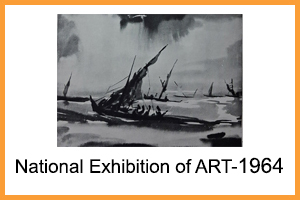

Roopa-Lekha Magazine, AIFACS publication
The National Exhibition of Art – 1964
By MANOHAR KAUL
Roopa-Lekha Magazine
The Lalit Kala Akademi received for its consideration about 1,300 works from about 600 artists from all parts of the country, representing a vast variety—idioms, styles, and techniques—covering some works of well-known artists along with those of novices, imitators, students, and amateurs. Out of this confused mass, only 159 paintings, 28 sculptures, and 24 graphics by 165 artists were selected for display. On the whole, the exhibition bears a national character, justifying the Akademi’s role of catering to all tastes, schools, and thoughts. No prevalent art trend has been discouraged. Every mode and pattern has been accepted and presumably judged on its merits, evaluated according to its own standards. In judging exhibits for awards, consideration of the relative merit of different works is supposed not to have been lost sight of—though there were some other outstanding works deserving of an award which unfortunately escaped the notice of the judges. The paintings by Jyotish Bhattacharjee, Bimal Das Gupta, and Laxman Pai belonged to this class. Each award-winning work stands upon its own individual character and, with some exceptions, possesses artistic qualities of considerable value. As a matter of course, the judges were expected to take into account the intrinsic merit of each work, provided it coordinated with the canons of art standards—irrespective of the style or mode in which they were executed. But in this respect, the public opinion remained sceptical. Its proof positive is seen in the lack of merit in some works out of the ten judged deserving of an award. Moreover, no masterpiece of enduring value—or even of outstanding merit—was forthcoming from the huge mass of exhibits received to deserve the Gold Plaque, which was withheld this year as well. Though this fact throws credit to the Judging Committee for doing its duty, it also reflects adversely on the state of contemporary art and the activity of the artists in the country, who seem to be hibernating rather than progressing. G.R. Santosh’s painting Nearer to Thee My Lord is undoubtedly the expression of the artist’s personal experience and consequential conviction he had in his Himalayan journeys. Here he depicts, so to say, the mystic significance and grandeur of the lofty Himalayas, where he felt as if he were near the seat of God—supposed in mythical lore to be high up in the clouds. It is no doubt a non-figurative abstract piece of deep spiritual significance and, in abstract idiom, rightly assessed as one of the best exhibits for an award. K.C. Aryan’s Portrait of God, on the contrary, is a cleverly devised wire mesh—an ingenious assemblage of wire, gauze, nails, and other metal pieces—into a formal rocket-like pattern. It is the latest by-product or clever freak of modern creative art into which this type of art dissipates itself and finds an escape. Such vagaries hardly deserve a notice, much less a place in the art gallery, and least of all, an award. M.F. Husain, who along with other popular artists had chosen to remain out of this exhibition, may be noted here. It may, however, be added that Biren De has a remarkable sensibility for colour, which imparts verve and vitality to his paintings. His Dying Ogre is again a dramatic and soul-chilling canvas, depicting in modern idiom the "grotesque", sublimated into a specific art by modernists. But the painting is under attack by both the modernists and the partisan critics. It is still a progressive and living trend in the realm of art in India. V.B. Smart’s Bazar is a good narrative in colour, in the neo-traditional style. Though the painting loses some of its charm by overemphasizing detail, it has high decorative value due to well-restrained colour harmonies. D.G. Sangwai’s Rema is an interesting portrait study in the academic style. Even with bold sweeps of brush strokes, the artist has created a compelling image. Barring a few exceptions, the exhibits do not show an impressive record, nor in any way represent the best in the country. The reason being that the majority of the works exhibited belonged to a modern idiom—one which Indians will have to develop a taste for, in order to appreciate. Mr. Chagla, the Education Minister, while opening the exhibition, rightly exhorted the artists not to forget the concept of their "Indianness" in their zeal to "sell" to the foreign markets. The disposition of sculptures and graphics, on the whole, has been better. Here, one can discern works of merit like Dhan Raj Bhagat’s tectonic pieces. Phul Chand Pyne’s torso in wood is rather attractive. The graphics of Badri Narayan, Somnath Hore, Pradumna Tana, and Gunen Ganguli show superb quality and fine workmanship. On the whole, they are satisfactory, though better examples were available in the plastic section of the exhibition. “Two Figures”, a copper cast by P.V. Janakiram, and A Form, a cement cast by Balakrishna Guru, are two sculptural pieces in modern style, showing some pattern and vitality of a specific type. The latter is much akin to child art, and the former impresses with its humorous pose. It is, however, gratifying to note that a prize has been awarded to a portrait, as it is well known that the art of portraiture has received a serious setback in the country due to the so-called “new values” in art today. The awarded work has well succeeded in laying bare the inner peace and well-poised mood of the subject.
